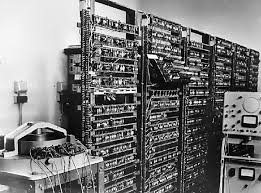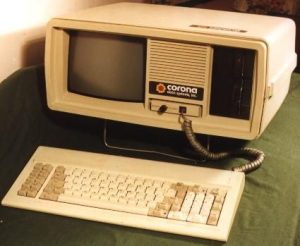Nowadays, computers or smartphones are everywhere. You will rarely find a home without at least one PC system or gaming console, and most of us have at least one smartphone. But this wasn’t always the case, especially 2-3 decades before. In this article, we will quickly examine how we managed to get to this point. Which were the most crucial time stamps in this journey? I will try to mention as many as possible, but please keep in mind that there are so many that 1000 articles are required to mention all of them. So, without further ado, let our journey begin!

Ancient times: Ancient civilizations, including ancient Greeks, Sumerians, etc., tried to save time for complex calculations, e.g., for astronomy, we should consider that they invented some simple analog computing devices to help them. It might be just a hypothesis, but it still is a possibility.
250 to 80 B.C.: The birth of the so-called Antikythera mechanism. It is considered the first analog computer that has been found yet. It is possible not to be the first or the best of its kind.
80 B.C. to 19th Century A.D.: A set of analog devices exist to help people. Throughout the timeline, bright personalities and scientists helped with their theories and experiments. It is not necessarily to make a computer, but to make things easier or one step closer. We pretty much owe a lot to all of them.
1801: Joseph Marie Jacquard invents a punched wooden cards loom.
1821: Charles Babbage with his steam calculating machine concept, later known as the “Difference Engine.”
1848: Ada Lovelace and the first computer program concept.
1853: Per Georg and Edvard Scheutz, the first printing calculator concept.
1890: Herman Hollerith designed the 1890 U.S. punch card system.
1931: Vannevar Bush invents the Differential Analyzer at MIT.
1936: Alan Turing and the Turing Machine help the Allies win World War II.
1937: John Vincent Atanassoff suggests an electric-only computer.
1941: The Z3 machine of Konrad Zuse.
1941: The Atanassof-Berry Computer (ABC).
1945: The “First Draft of a Report on the EDVAC” by John Von Neumann.
1945: The “birth” of ENIAC (Electronic Numerical Integrator And Calculator).
1946: UNIVAC concept, the first commercial computer, referred only to business and government applications.
1947: The transistor invention at Bell Laboratories.
1949: EDSAC (Electronic Delay Storage Automatic Calculator).
1953: COBOL (COmmon Business-Oriented Language) by Grace Hopper.
1954: The FORTRAN programming language.
1957: IBM 305 RAMAC, the first HDD.
1958: The Integrated Circuit by Jack Kilby and Robert Noyce.
1968: “A Research Center for Augmenting Human Intellect” presentation by Douglas Engelbart, the father of the mouse-pointing device, in 1964.
1969: UNIX was born at Bell Labs.
1970: Intel 1103 DRAM chip, by Intel.
1971: The floppy disk was invented by IBM.
1972: The Magnavox Odyssey home game console.
1973: Ethernet development by Xerox.
1973: Xerox Alto, the first GUI device.
1975: The first actual IP router was developed by BBN.
1975: Microsoft was founded.
1975: IBM 801 development, the first RISC (Reduced Instruction Set Computer) system. Smartphones and a wide variety of handheld (and not only) devices owe too much to this instruction set.
1976: Apple Co. was founded, and the Apple I computer followed.
1977: TRS-80 by Radio Shack.
1977: 80-103A, the first commercial PC modem.
1977: The Commodore Personal Electronic Transactor (PET).
1977: Apple II.
1978: VisiCalc.
1979: WordStar, the first commercial word processor, by MicroPro International.
1981: IBM Personal Computer (model 5150, commonly known as the IBM PC) that utilized MS-DOS.
1981: The Osborne 1, the first commercial laptop.
1983: Apple LISA (Local Integrated Software Architecture).
1985: Windows 1.0x.
1989: The World Wide Web and Hyper Text Markup Language, concept by Tim Berners-Lee at CERN.
1989: The GRidPad 1900 by GRiD Systems, the first commercial ancestor of modern-day tablets.
1991: Linux by Linus Torvalds.
1991: The first SSD by Sandisk.
1992: IBM Simon (The Simon Personal Communicator), the first commercially available smartphone, was developed and released in 1994.
1992: Samsung KM48SL2000 chip, Synchronous Dynamic Random Access Memory (SDRAM).
1993: The Pentium microprocessor.
1995: Windows 95, the OS that established Microsoft as the world’s OS PC dominator, was released.
1996: 3DFX Voodoo Graphics, the first graphics cards designed and marketed for gaming.
1996: The “Google Search Engine” development at Stanford University by Sergey Brin and Larry Page.
1999: Nvidia GeForce 256 AIB was marketed as the world’s first GPU.
1999: Wi-Fi (Wireless Fidelity) development.
2003: AMD Athlon 64, the first commercial 64-bit microprocessor for PCs.
2003: Android inc was founded, the developer of the Linux Kernel-based OS.
2004: Mozilla Firefox 1.0 Web browser was released.
2005: Android was acquired by Google.
2006: AMD acquired ATI.
2007: Apple’s iPhone was released and is considered the first real smartphone by today’s standards.
2008: Chromium web browser is the father of all Chromium web browsers, including Google Chrome.
2010: Apple’s iPad was released and is considered the first real tablet by today’s standards.
2011: Introduction of NVMe.
2015: RISC-V was introduced.
2016: Creation of the “first reprogrammable quantum computer.”
2017: “Molecular Informatics” by DARPA.

Epilogue
Making a complete list for this article’s subject was challenging. This list is a brief example of important events that contributed to modern computer science, technology, and evolution. So, if something important isn’t mentioned, it wasn’t on purpose. We owe an excellent “thank you” to all the famous and non-famous heroes that played their part in technological advancement. You can add your suggestions in the comment section or our Forum. Your love and support are essential to us. Stay safe, and stay in the know!



WOW! What a blast from the past. Brought back a lot of memories. My original IBM pc from 1987 is long gone but I still use my IBM Model D keyboard from the 1980’s. It is indestructible!
yes, articles like that are somewhat a blast from the past! 1987? i was 1 yrs old, back then!
ROFLMAO! I took my first computer class at the University of Nebraska in the Fall of 1971. Had to learn binary code. Programming was done using IBM punch cards. Yes, I am a dinosaur – 52 years of computing and still going strong!
WOW! Hope you manage 100 computing years and be strong! Thank you for your comment! And I thought that I had years in Computex, I am just an 80s kid 🙂
My respect to people that still go strong after so many years. I am 37 yrs old and I thought that I was already a dino. As Aris mentioned 100 yrs and keep going strong. Thanx for your comment.